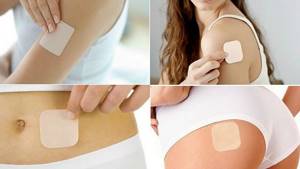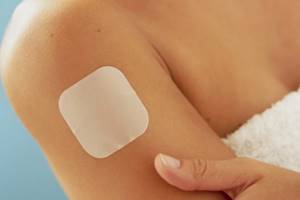Medicine does not stand still: more and more new and modern developments are appearing on the market. One of them is a transdermal contraceptive patch, which replaced condoms and pills that were not very easy to use. The patch is a thin, smooth plate measuring 20 by 20 cm, which is impregnated with special hormonal substances that interfere with the ovulation process.
How it works
This product is a hormonal product patented by Johnson & Johnson, one of the giants among manufacturers of pharmaceutical and hygiene products. The adhesive plaster is applied once a week and has a high degree of protection against pregnancy - up to 99.4%. After 7 days, the plate is removed and replaced with a new one.
Every day, active ingredients are released into the blood from the glued Evra plate: 150 micrograms of norelgesromine and 20 micrograms of ethinyl estradiol. They act on the female body in such a way that the egg is not produced, ovulation does not occur and, as a result, the process of fertilization is impossible. At the same time, the chemical composition of the cervical mucosa changes in the vagina, and this is an additional obstacle to the penetration of sperm into it. Both of these complementary factors provide a high percentage of protection.
It is important to understand that the transdermal contraceptive patch protects against unwanted pregnancy, but not against sexually transmitted diseases. In this regard, it is recommended to use it only with a regular sexual partner, in whose health you are confident. This remedy is optimal for married couples who do not plan to produce offspring.
Advantages and disadvantages of using a patch
Correct use of the contraceptive patch protects against unwanted pregnancy in 99 percent of cases. The main advantages of this method of contraception include the following among specialists and women who use it:
- Convenience and ease of use: the tablets need to be taken every day, and the patch is applied once a week. Very suitable for the forgetful
- The patch is waterproof , no need to worry that it will come off in the shower
- the dose of hormones is less than when taking pills. The liver does not suffer
- there is no need to interrupt coitus
- no special skills to use
- Only once a week should the patch be replaced with a new one
- hormonal substances do not enter the stomach, while remaining effective
- like other hormonal drugs, the patch helps improve menstruation, making it more regular and less painful
- using the patch reduces the risk of diseases such as ovarian, uterine, and intestinal cancer; and also reduces the risk of fibroids, ovarian cysts and non-cancerous breast diseases
Also read: Escherichia coli how to treat
However, there are also disadvantages to using the contraceptive patch. Among them are the following:
- This is a hormonal contraceptive
- the patch will most likely be visible on the skin
- the area where you put the contraceptive patch may sometimes be itchy
- it may peel off if it comes into frequent contact with water
- it cannot protect against diseases that are sexually transmitted
- some women experience minor side effects such as migraines, nausea, chest pain and heaviness and mood changes
Note that the side effects disappear after several months of using the patch.
Instructions for use

Before using a protective adhesive plaster, it is advisable to consult a gynecologist to make sure there is no pregnancy, undergo a physiological examination and obtain permission to use it.
Let's consider such important questions about the contraceptive patch as instructions and price. The cost of this product, at first glance, seems rather high - from $15 per package. But relative to its effectiveness, such pricing is quite justified.
The patch is applied on the first day of the menstrual cycle, and there is no need for additional products. And you can also stick it on any other day, but for the first 7 days additional non-hormonal contraception is required, for example, in the form of a condom.
The patch can be applied to the back, stomach, thighs or shoulder. The place where the patch will be placed must first be washed well and wiped dry, without applying any cosmetic creams afterwards. And also, do not apply adhesive plaster to irritated and injured areas of the skin. The next patch should be placed in a new location.
You should not stick two or three patches at the same time: this will not increase the degree of protection, but will only cause side effects.
It should be used according to the following scheme: on the first day of menstruation, the eighth and the fifteenth. After three uses, you need to take a 7-day break. The time of day of the sticker does not matter.
Advantages of the product
This contraceptive has many positive aspects:
it is not visible at all under clothes;
- and also you do not have to constantly keep in mind the time of daily intake, as is the case with oral medications;
- the patch is applied once a week and stays on the body quite firmly - it does not peel off or dry out;
- it does not in any way affect a woman’s usual image: she can, as usual, take a bath, sunbathe, visit the sauna and pool, and be physically active.
Another great advantage of patches is its therapeutic effect on the body. If a girl suffers from painful periods and does not tolerate premenstrual syndrome well, then all these problems end with the use of this remedy.
Contraindications for use
Like any medical product, the Evra contraceptive patch has a number of contraindications, including:

age under 18 years;
- malignant tumors;
- postpartum period and lactation period;
- vaginal bleeding;
- menstrual irregularities;
- venous and arterial thrombosis;
- history of stroke, heart attack;
- liver failure;
- diseases of the cardiovascular system;
- hypertension.
Also, this product is not recommended for use by women over 35-40 years of age, as well as by those who smoke more than 15 cigarettes per day. You should absolutely not apply the patch to the chest area.
Side effects
The side effects of the Evra patch are the same as those of other similar products. The most common of these are chest discomfort, nausea, headache, and skin irritation at the site of use.
It is worth noting that many side effects can go away on their own after 2-3 months of using the drug.
If the patch comes off
Typically, the adhesive plaster sticks to the skin very well and rarely comes off. If the patch suddenly comes off, don’t panic. In this case, press it firmly against the skin for 10-15 seconds. If this does not help, then you need to change it to a new one.
In a situation where the contraceptive patch came off, but you did not notice it and went on like this for 2-3 days, you need to use a new one and for the first 7 days after that use additional means of protection of non-hormonal origin.
Missed days
If, due to forgetfulness, the replacement of the product was not carried out on time after the first week of use, and this delay was more than one day, then you need to replace the used patch with a new one and use additional precautions during the week. Moreover, the day of sticking the second hormonal patch should be considered the first day of the second week.
If a similar incident occurred in the second or third week, then the adhesive plaster should simply be replaced, provided that no more than two days have passed. The next patch should be glued on a regular day, originally calculated. If more than 2 days are missed, the day of applying a new patch should be considered a new starting point, and the use of auxiliary contraception is recommended.
How to use the contraceptive patch?
The cycle of use of the contraceptive patch is considered to be twenty-one days or three weeks. This is followed by one week of rest.
Please note that you should not remain without the patch for longer than one week. Otherwise, the contraceptive properties will be lost.
In order for the use of a contraceptive patch to achieve maximum effect, experts advise choosing the right place for gluing and selecting one specific day of the week for replacement. Consider these two tips in more detail.
First , you need to choose a place on the body where you will glue the contraceptive patch. Here you should pay attention to some subtleties:
- clean skin - applying oils, creams, balms to the place where you will stick the patch is contraindicated
- there should be no damage
- smooth skin - do not apply the patch on folds or where the skin often wrinkles
- “bald” skin – a minimal amount of hair at the site where the patch is applied promotes stronger adhesion and also minimizes the pain effect when the patch is peeled off
- loose skin - avoid the patch rubbing frequently against the fabric of clothing
Under no circumstances should you apply a contraceptive patch to your chest.
Secondly , you need to carefully choose the day on which you will stick the contraceptive patch.
Experts insist that you not only remember, but write down the day of the week when you first applied the patch. A new patch must be applied on the same day of the week.
The first day of your menstrual cycle is considered the first day of using the contraceptive patch. It is on this day that you need to glue it for the first time, and then every week on the same day you need to change it to a new one for 3 weeks, then you need to take a break of seven days.
On the eighth day, use of the contraceptive patch is resumed. From this day a new cycle begins.
Please note that you must start applying the patch, even if you have not stopped bleeding.
How to properly protect yourself with a plaster
Before you start using the patch, you need to choose the right area of skin to stick it to the body.
Selecting an area for gluing
When choosing a place to apply the contraceptive patch, follow the following rules.
- The patch is applied to clean skin (it is prohibited to apply oils or gels to the skin before gluing the patch, this will reduce adhesion).
- The selected area should not be damaged (cuts, inflammation, abrasions, scratches).
- You need to choose the most flat area possible; gluing the patch on the folds is prohibited.
- There should be as little hair as possible.
- The appliqué area should come into contact with clothing as little as possible.
- Wearing the patch on the mammary glands is strictly prohibited.
The optimal areas for gluing the patch will be the buttocks, lower abdomen, shoulders and shoulder blades. Periodically, the gluing locations need to be changed.

Scheme for using the patch
On the first day of menstruation, the patch is applied to an area of the body selected in accordance with the rules above. Write down the day the first patch was applied. The branded packaging contains special stickers to mark the days when the next plate is to be applied.
Also read: How to treat ovarian inflammation at home
You need to peel off the first one and stick on the next one exactly a week later, on the eighth day of the monthly cycle. Another week later, on the 15th day of the cycle, the second sticker changes to the third. A week after the third sticker is attached, it is peeled off. Then follows a week's break.
After 7 days, another patch is applied (even if the bleeding has not stopped), and the pattern is repeated. If the break lasts longer than a week, the level of hormones in the body decreases and the contraceptive effect weakens.
Stickers must be changed on the same day of the week. To avoid missing replacement time, the easiest way is to set a reminder or alarm on your smartphone.
What to do if the patch comes off or is replaced later than necessary
If only part of it comes off, try sticking the patch to the skin again. If the patch cannot be glued back firmly enough or it has come off completely, you need to glue a new one as quickly as possible.

If more than a day has passed from the moment the sticker was peeled off until a new sticker was attached, then barrier protection must be used over the next week. Now the first day of wearing will be considered the day of gluing the new plate, and the scheme must be calculated from it.
If the sticker was changed later than it should have been, you need to act depending on the specific situation:
- the time is overdue by less than 2 days - replace the sticker with a new one, and attach the next one on the day corresponding to the scheme; protection with barrier methods over the next week is not required;
- the replacement is overdue for more than 2 days - replace the sticker as quickly as possible, protect yourself with barrier contraceptives for the entire next week, and build a scheme, considering the first day to be the day you change the expired patch;
- after 3 weeks of wearing the sticker is not removed on the right day - remove the patch as soon as possible, and start the next cycle as planned, barrier protection is not needed.
If a woman wants to change the method of birth control from hormonal pills to a patch, she needs to stick it on the first day of menstruation, which begins after finishing taking the pills. If the discharge has not started 5 days after stopping the pills, this may be a sign of pregnancy. If you suspect pregnancy, you should not use the contraceptive patch until the true state of affairs becomes clear.












